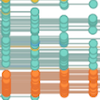Abstract
H3N2: In H3N2, clade 3c2.a has continued to diversify genetically with complicated and rapid dynamics of different subclades. This diversification is not reflected in serological data that shows only minor to moderate antigenic evolution. Nevertheless, the highly parallel mutation patterns and the rapid rise and fall of clades suggests competitive dynamics of phenotypically distinct viruses.
H1N1pdm: Very few H1N1pdm viruses have been observed in recent months. The dominant clade continues to be 6b.1 and there is little amino acid sequence variation within HA. The only notable subclade that has been growing recently is the clade bearing HA1:R205K/S183P. This clade is dominated by North American viruses and we see no evidence that this clade has a particular competitive advantage.
B/Vic: Clade 1A has continued to dominate and mutation 117V has all but taken over the global population. The rise of this mutation was fairly gradual and we have no evidence that it is associated with antigenic change or other benefit to the virus.
B/Yam: Clade 3 has continued to dominate. Within clade 3, a clade with mutation HA1:251V is globally at frequency of about 80% throughout 2016. Within this clade, mutation 211R is at 25% frequency. In addition, a clade without prominent amino acid mutations has been rising throughout 2016.
